The Impact of Return-to-Field and Targeted Trap-Neuter-Return on Feline Intake and Euthanasia at a Municipal Animal Shelter in Jefferson County, Kentucky
Simple Summary
Abstract
1. Introduction
1.1. Key Terminology
- Feral cats: Generally used to describe unowned, free-roaming cats, especially those who are not socialized to humans either because they have never had human contact or because they have, over time, reverted to a “wilder” state in the absence of such human contact.
- Stray cats: Generally used to describe owned cats (i.e., pets) who have become lost or displaced from their homes or property. Shelters generally use the term more broadly, considering cats admitted to be “strays” if they have no known owner and lack discernible identification (i.e., collar and tags, or traceable microchip).
- Community cats: Broadly used to describe unowned, free-roaming cats regardless of their sociability. The term is becoming more popular in part because of its implicit acknowledgment that cats are a commensal species and are highly valued by many residents.
- Trap-neuter-return (TNR): A non-lethal method for managing community cats whereby cats are humanely trapped, surgically sterilized, and returned to their original location. TNR programs often vaccinate cats against rabies as well (Figure 1).
- Return-to-field (RTF): Essentially TNR for cats brought into an animal shelter, either by residents or a shelter’s field services staff, as “strays” lacking identification (i.e., collar/tags or traceable microchip). Rather than house these cats only to kill most of them following the designated “stray hold” period, shelters sterilize, vaccinate, and return them to the outdoor location where the cats were living. Also sometimes called shelter-neuter-return, or SNR (Figure 1).
- Community Cat Program (CCP): The name given to shelter-based programs in which RTF and TNR efforts were carefully integrated in an attempt to maximize lifesaving and population reduction.
- Sterilization: Various terms are used to indicate the surgical sterilization of cats (e.g., spay, neuter). Here, we are using the term sterilization broadly to indicate the removal of the reproductive organs in both male (testicles) and female (ovaries) cats.
- Alley Cat Advocates (ACA): A private non-profit organization located in Louisville, KY, that provides no-cost TNR services to residents of the Louisville Metro area.
- Louisville Metro Animal Services (LMAS): The municipal animal shelter serving residents of the Louisville Metro area.
- Kentucky Humane Society (KHS): A private non-profit organization located in Louisville, KY, that provides a range of services (e.g., low-cost sterilization of pets and adoption of pets) mostly to residents of the Louisville Metro area.
- Live-release Rate (LRR): A metric commonly used to describe animal shelter outcomes, defined as live outcomes divided by all outcomes except owner-requested euthanasia and animals who died or were lost while in the shelter’s care, represented as a percentage.
- Return to Owner (RTO): The ratio of animals reunited with their owners to total shelter intake, represented as a percentage.
- Length of Stay (LOS): The amount of time (usually expressed in days, as an average) between an animal’s admission to a shelter and their eventual outcome.
- Euthanasia Rate: The ratio of the number of cats euthanized for reasons other than owner request to the total number of feline intakes over a given period of time, represented as a percentage.
1.2. Site Description and Background Information
2. Materials and Methods
2.1. Data Collection
2.2. Data Analysis
3. Results
3.1. Enrollment and Surgeries
3.2. Impact on Shelter Metrics
4. Discussion
4.1. Reductions in Euthanasia
4.2. Reductions in Stray Intake
4.3. Other Shelter Metrics of Interest
4.4. Key Differences in Jefferson County’s Trap-Neuter-Return (TNR) and Return-to-Field (RTF) Programs
5. Study Limitations
6. Conclusions
Author Contributions
Funding
Acknowledgments
Conflicts of Interest
References
- Clancy, E.A.; Rowan, A.N. Companion Animal Demographics in the United States: A Historical Perspective. In The State of the Animals II.; Salem, D.J., Rowan, A.N., Eds.; Humane Society Press: Washington, DC, USA, 2003; pp. 9–26. [Google Scholar]
- Zawistowski, S. Simulating different approaches for managing free-roaming cat populations. In 2013 National Council on Pet Population Research Symposium Presentations: CATS: The ins and Outs: Improving their Future Through Research; Society of Animal Welfare Administrators: Tempe, AZ, USA, 2013. [Google Scholar]
- Rowan, A.; Kartal, T. Dog Population & Dog Sheltering Trends in the United States of America. Animals 2018, 8, 68. [Google Scholar] [CrossRef]
- Best Friends Animal Society. A New Digital Tool for Saving Dogs and Cats: Is Your Community No-Kill? Available online: https://bestfriends.org/2025-goal (accessed on 13 September 2019).
- U.S. Census Bureau. QuickFacts: United States. Available online: https://www.census.gov/quickfacts/fact/table/US/PST045218 (accessed on 13 September 2019).
- Zawistowkski, S.; Morris, J.; Salman, M.D.; Ruch-Gallie, R. Population Dynamics, Overpopulation, and the Welfare of Companion Animals: New Insights on Old and New Data. J. Appl. Anim. Welf. Sci. 1998, 1, 193–206. [Google Scholar] [CrossRef] [PubMed]
- Hurley, K.F.; Levy, J.K. New Paradigms for Shelters and Community Cats. Available online: https://vetmed-maddie.sites.medinfo.ufl.edu/files/2014/07/New-Paradigms-for-Shelters-and-Community-Cats.pdf (accessed on 16 May 2016).
- Alley Cat Allies. Cat Fatalities and Secrecy in U.S. Pounds and Shelters. Available online: https://www.alleycat.org/resources/cat-fatalities-and-secrecy-in-u-s-pounds-and-shelters/ (accessed on 22 November 2017).
- Marsh, P. Replacing Myth with Math.: Using Evidence-Based Programs to Eradicate Shelter Overpopulation; Town and Country Reprographics: Concord, NH, USA, 2010. [Google Scholar]
- Wolf, P.J.; Hamilton, F.E. Managing Free-roaming Cats in U.S. Cities: An Object Lesson in Public Policy and Citizen Action. J. Urban Aff. 2020, 1–22. [Google Scholar] [CrossRef]
- Spehar, D.D.; Wolf, P.J. Integrated Return-To-Field and Targeted Trap-Neuter-Vaccinate-Return Programs Result in Reductions of Feline Intake and Euthanasia at Six Municipal Animal Shelters. Front. Vet. Sci. 2019, 6, 2. [Google Scholar] [CrossRef] [PubMed]
- Bays, D.; Kortis, B.; Little, K.; Richmond, S. Return-to-Field Handbook; The Humane Society of the United States (in collaboration with Neighborhood Cats, Inc. and Alley Cat Advocates): Washington, DC, USA, 2019. [Google Scholar]
- Spehar, D.D.; Wolf, P.J. The Impact of an Integrated Program of Return-to-Field and Targeted Trap-Neuter-Return on Feline Intake and Euthanasia at a Municipal Animal Shelter. Animals 2018, 8, 55. [Google Scholar] [CrossRef] [PubMed]
- Kortis, B. Community TNR: Tactics and Tools; PetSmart Charities, Inc.: Phoenix, AZ, USA, 2014; Available online: http://www.petsmartcharities.org/pro/community-tnr-tactics-and-tools (accessed on 10 September 2019).
- Louisville: Location, History, Attractions, & Facts. Available online: https://www.britannica.com/place/Louisville-Kentucky (accessed on 18 September 2019).
- U.S Census Bureau. QuickFacts: Jefferson County, Kentucky. Available online: https://www.census.gov/quickfacts/jeffersoncountykentucky (accessed on 18 September 2019).
- All Shelters Are Not Alike: The Important Differences That Can Affect The Mission. The Humane Society of the United States Shelter Advocate Toolkit. Available online: http://www.humanesociety.org/assets/pdf/pets/shelter-advocate-toolkit/all_shelters_are_not_alike_.pdf (accessed on 17 April 2018).
- Association of Shelter Veterinarians. Shelter terminology. Available online: https:www.sheltervet.org/assets/PDFs/shelter%20terminology.pdf (accessed on 12 September 2019).
- U.S. Census Bureau. American FactFinder: Jefferson County, KY. Available online: https://factfinder.census.gov/faces/tableservices/jsf/pages/productview.xhtml?src=CF (accessed on 29 October 2019).
- Open Data Network. Population Density Data for Jefferson County, KY. Available online: https://www.opendatanetwork.com/entity/0500000US21111/Jefferson_County_KY/geographic.population.density?year=2017 (accessed on 29 October 2019).
- City-Data.com. 40215 Zip Code (Shively, Kentucky) Profile—Homes, Apartments, Schools, Population, Income, Averages, Housing, Demographics, Location, Statistics, Sex Offenders, Residents and Real Estate Info. Available online: http://www.city-data.com/zips/40215.html (accessed on 16 October 2019).
- Humane Society of the United States. Managing Community Cats: A Guide for Municipal Leaders. 2014. Available online: http://www.animalsheltering.org/page/managing-community-cats-guide-municipal-leaders (accessed on 20 September 2019).
- Louisville Metro Code. Animal Ordinances, §91.030. Available online: https://dev.louisvilleky.gov/government/animal-services/animal-ordinances?qt-toolbox=4 (accessed on 20 September 2019).
- Maddie’s Fund. Working Cat Programs. Available online: //www.maddiesfund.org/working-cats-program.htm (accessed on 20 October 2019).
- Christensen, J. Are Cats the Ultimate Weapon in Public Health? CNN Health. Available online: https://www.cnn.com/2016/07/15/health/cats-chicago-rat-patrol/index.html (accessed on 16 October 2019).
- Scott, K.C.; Levy, J.K.; Crawford, P.C. Characteristics of free-roaming cats evaluated in a trap-neuter-return program. J. Am. Vet. Med Assoc. 2002, 221, 1136–1138. [Google Scholar] [CrossRef] [PubMed]
- Johnson, K.L.; Cicirelli, J. Study of the effect on shelter cat intakes and euthanasia from a shelter neuter return project of 10,080 cats from March 2010 to June 2014. PeerJ 2014, 2, e646. [Google Scholar] [CrossRef] [PubMed]
- Cody, D.; (Jacksonville Animal Care and Protective Services, Jacksonville, FL, USA). Personal communication, 2019.
- Shelter Animals Count. 2018 Animal Sheltering Statistics. Available online: https://shelteranimalscount.org/data/data-reports/2018-animal-sheltering-statistics (accessed on 23 March 2020).
- Levy, J.K.; Isaza, N.M.; Scott, K.C. Effect of high-impact targeted trap-neuter-return and adoption of community cats on cat intake to a shelter. Vet. J. 2014, 201, 269–274. [Google Scholar] [CrossRef] [PubMed]
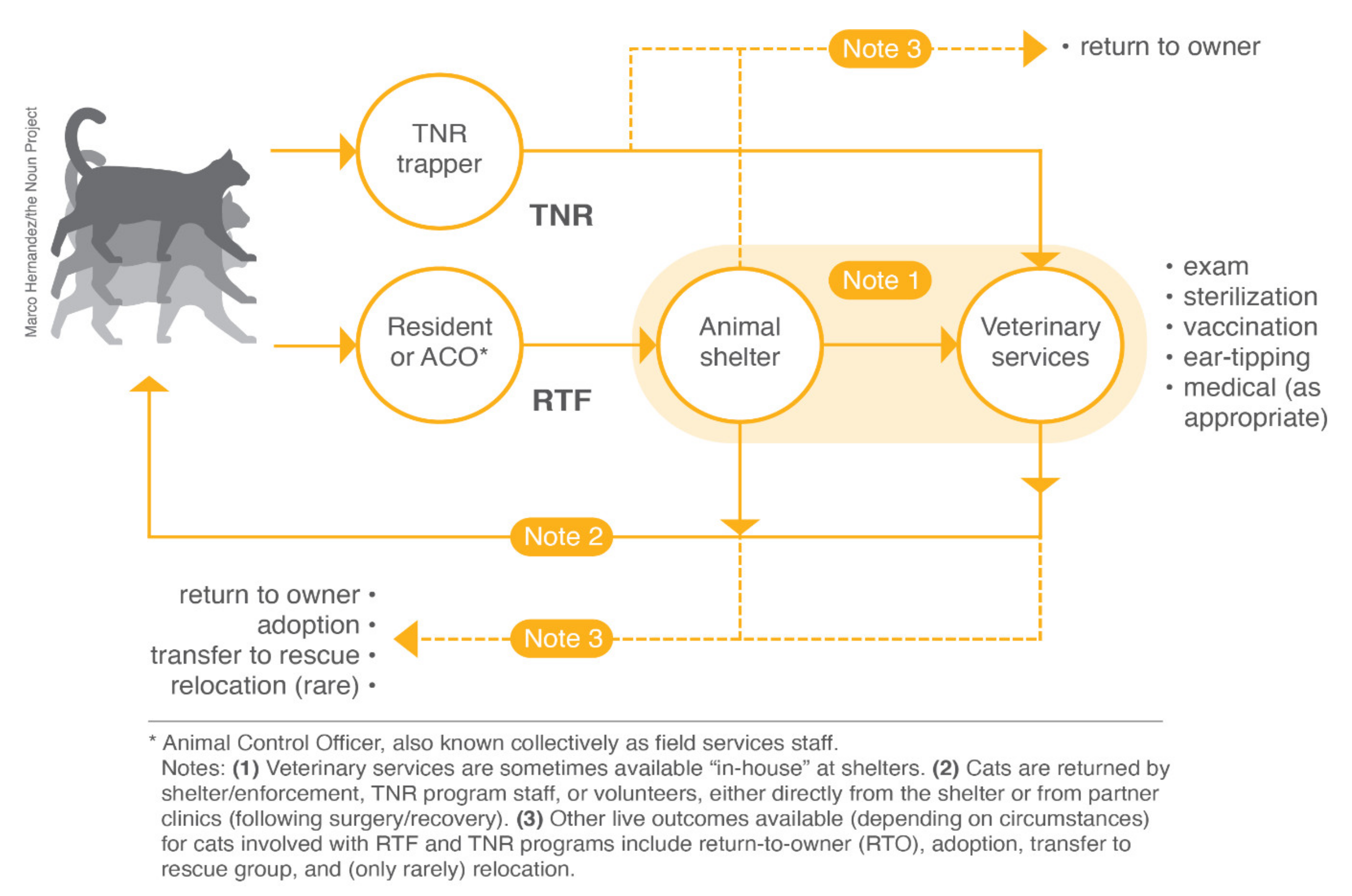
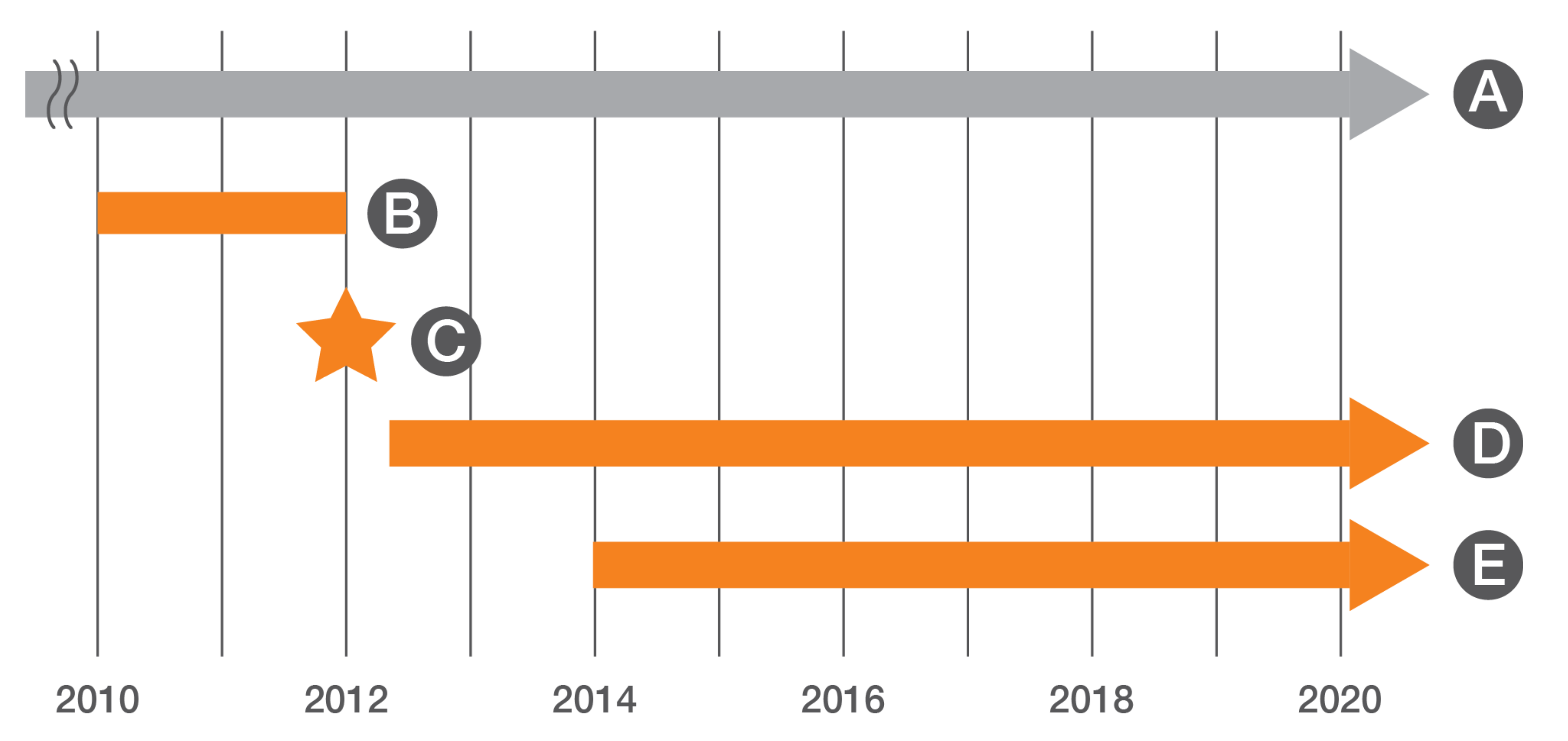
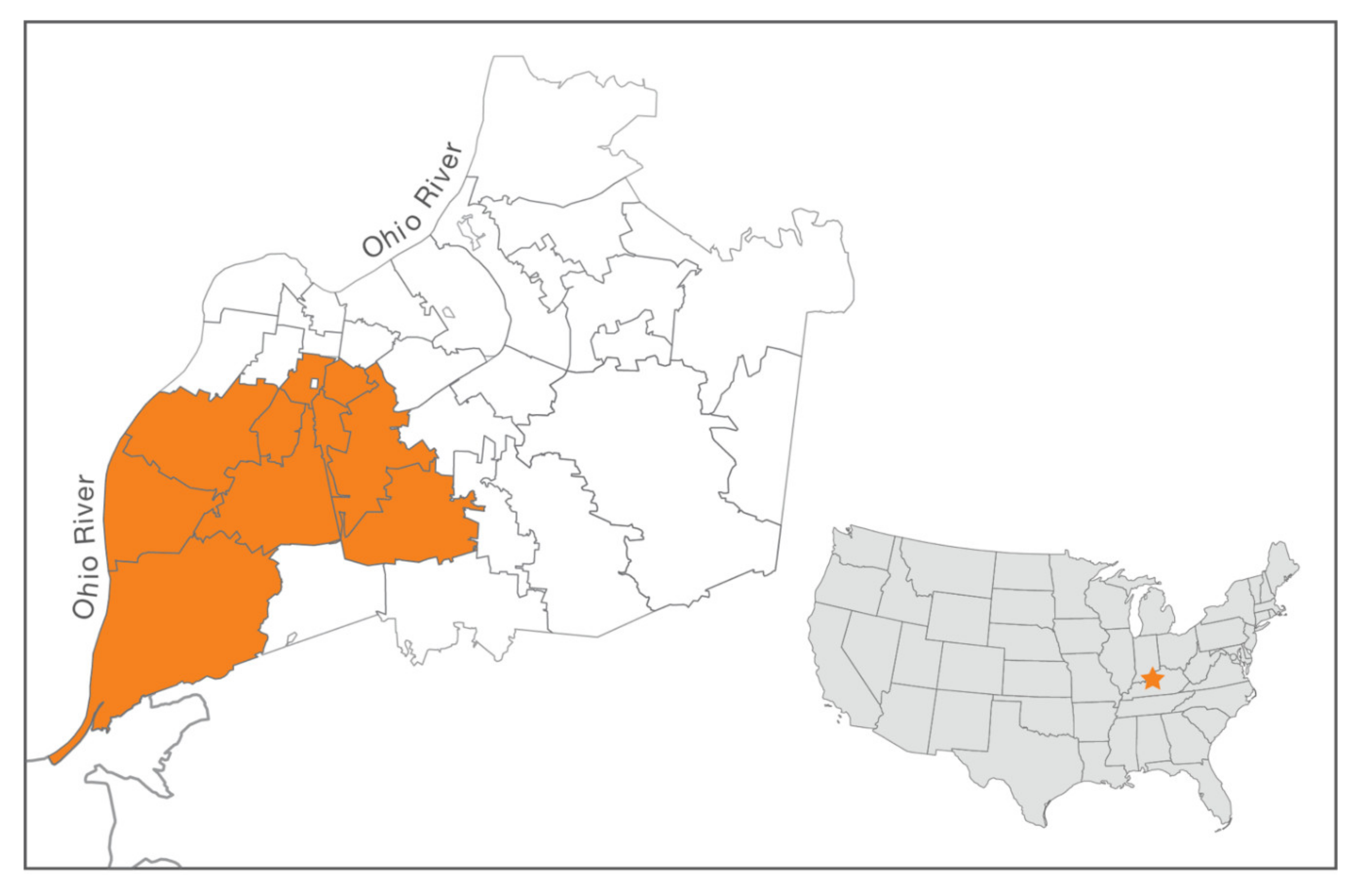
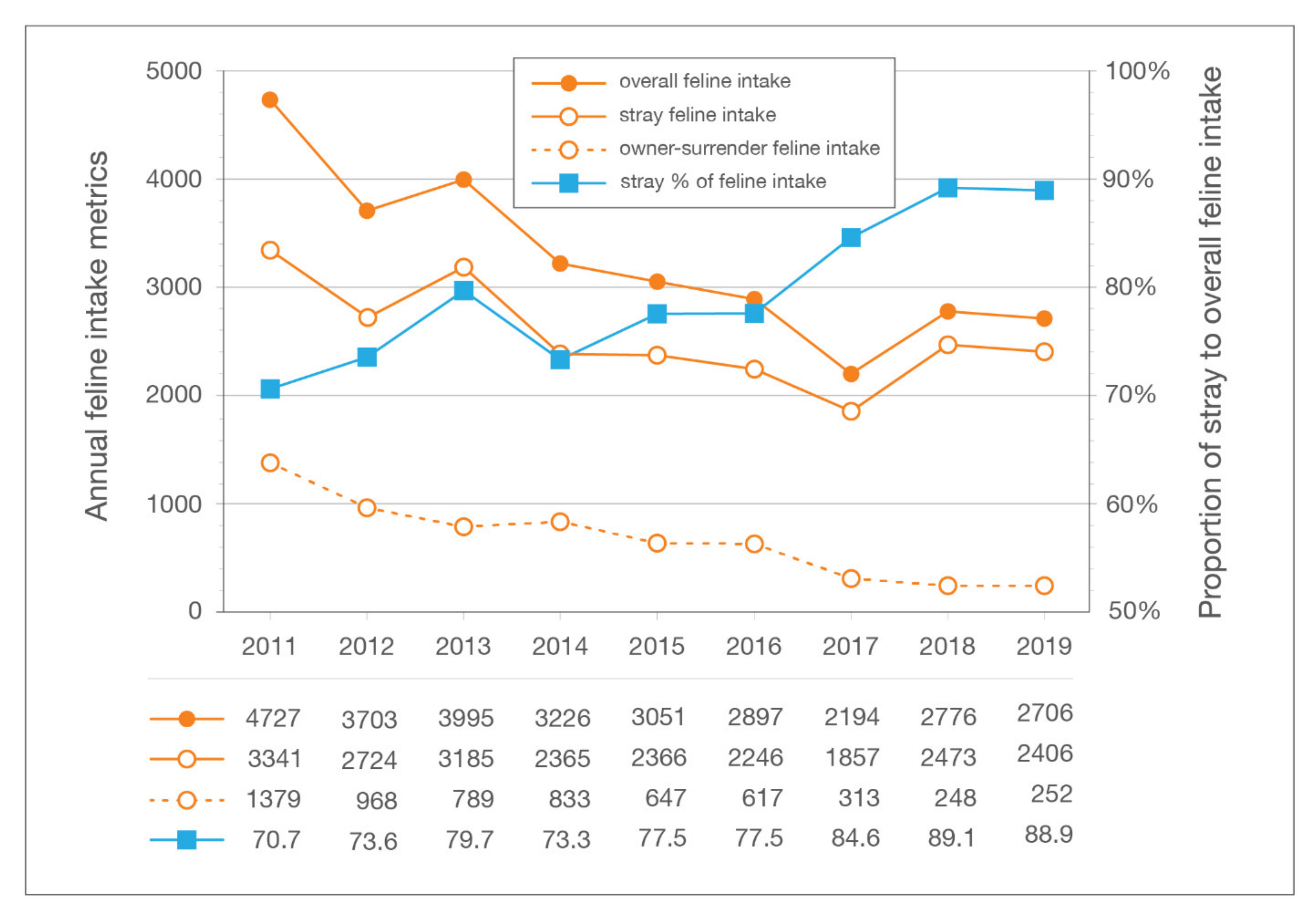
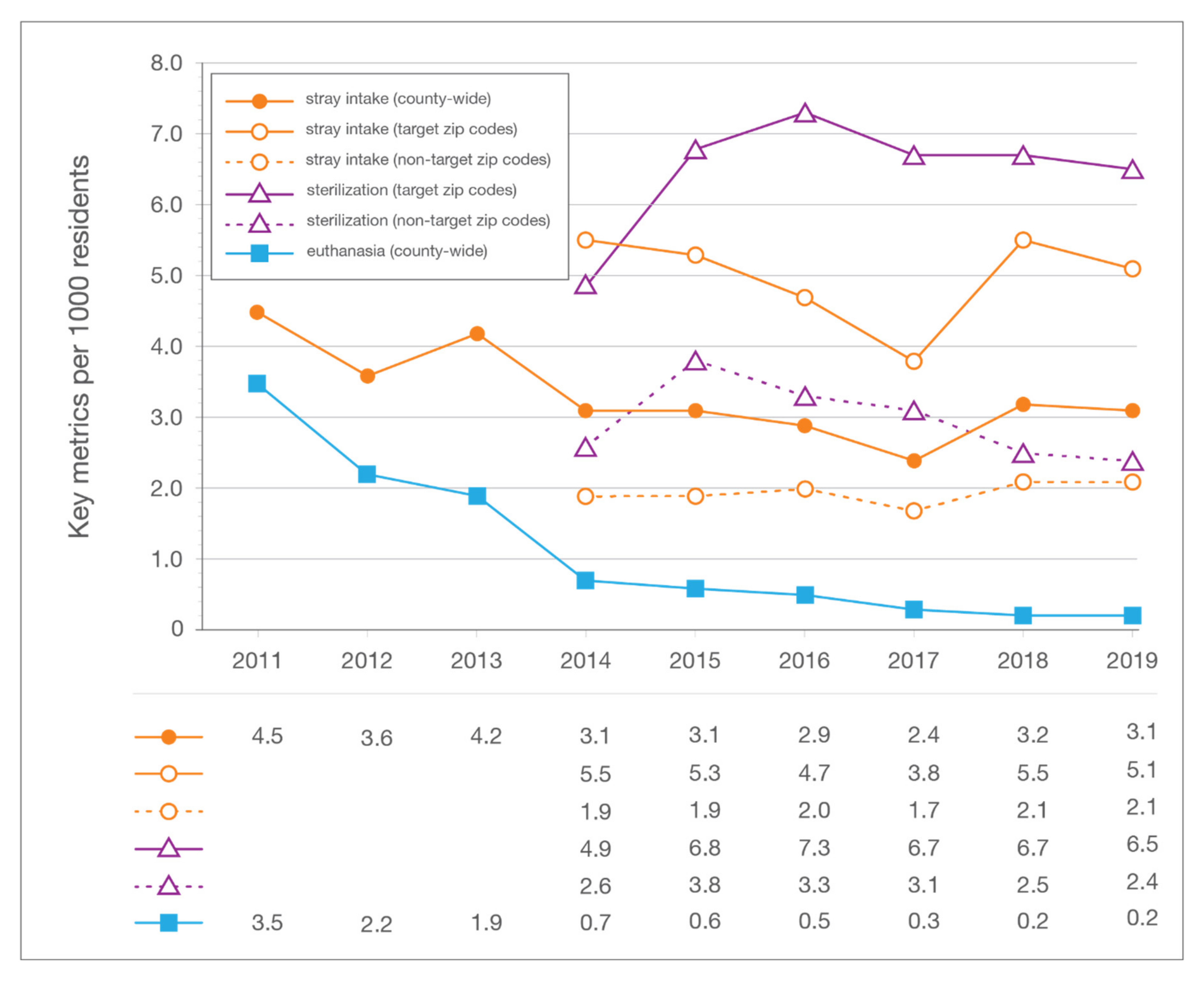
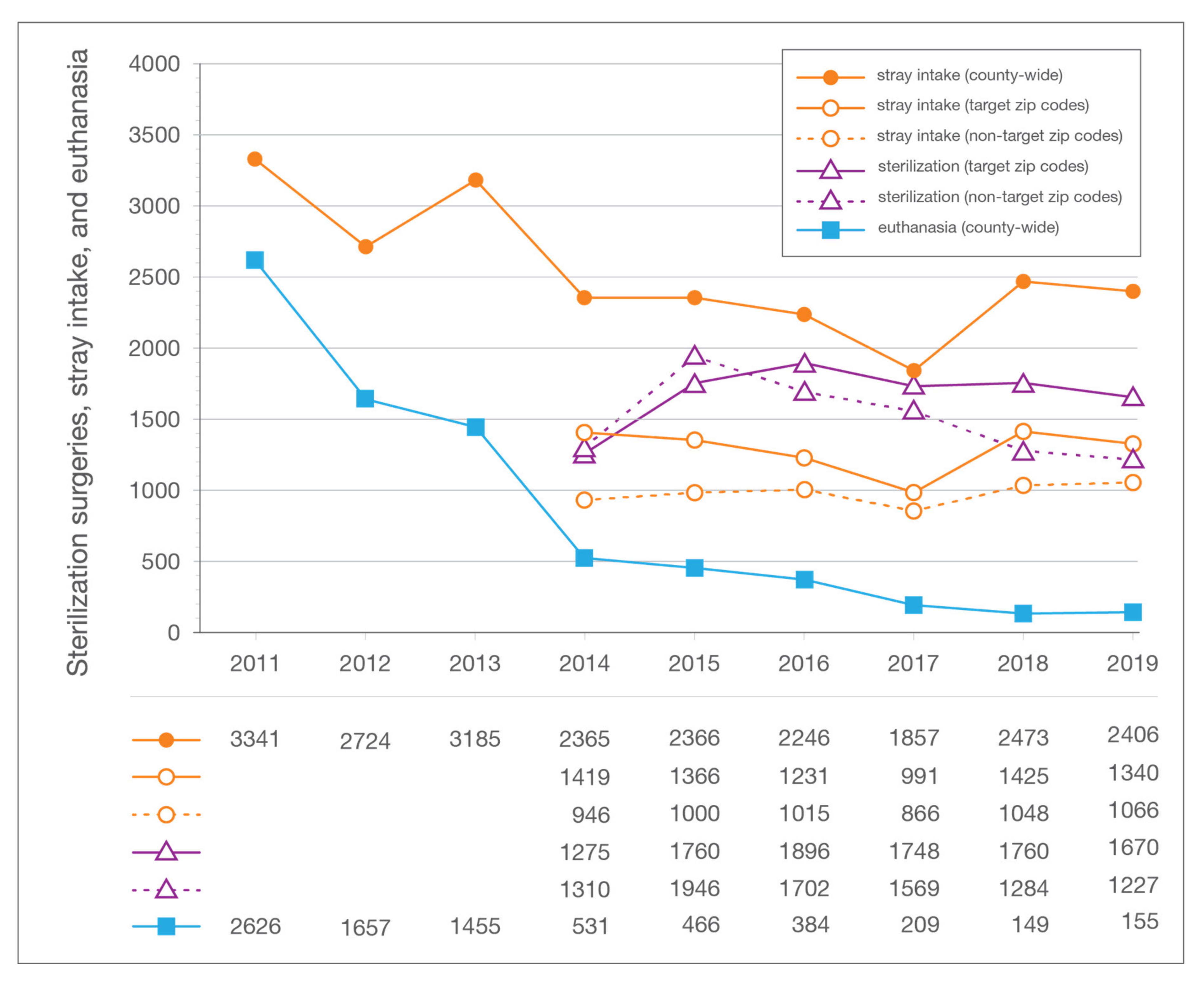
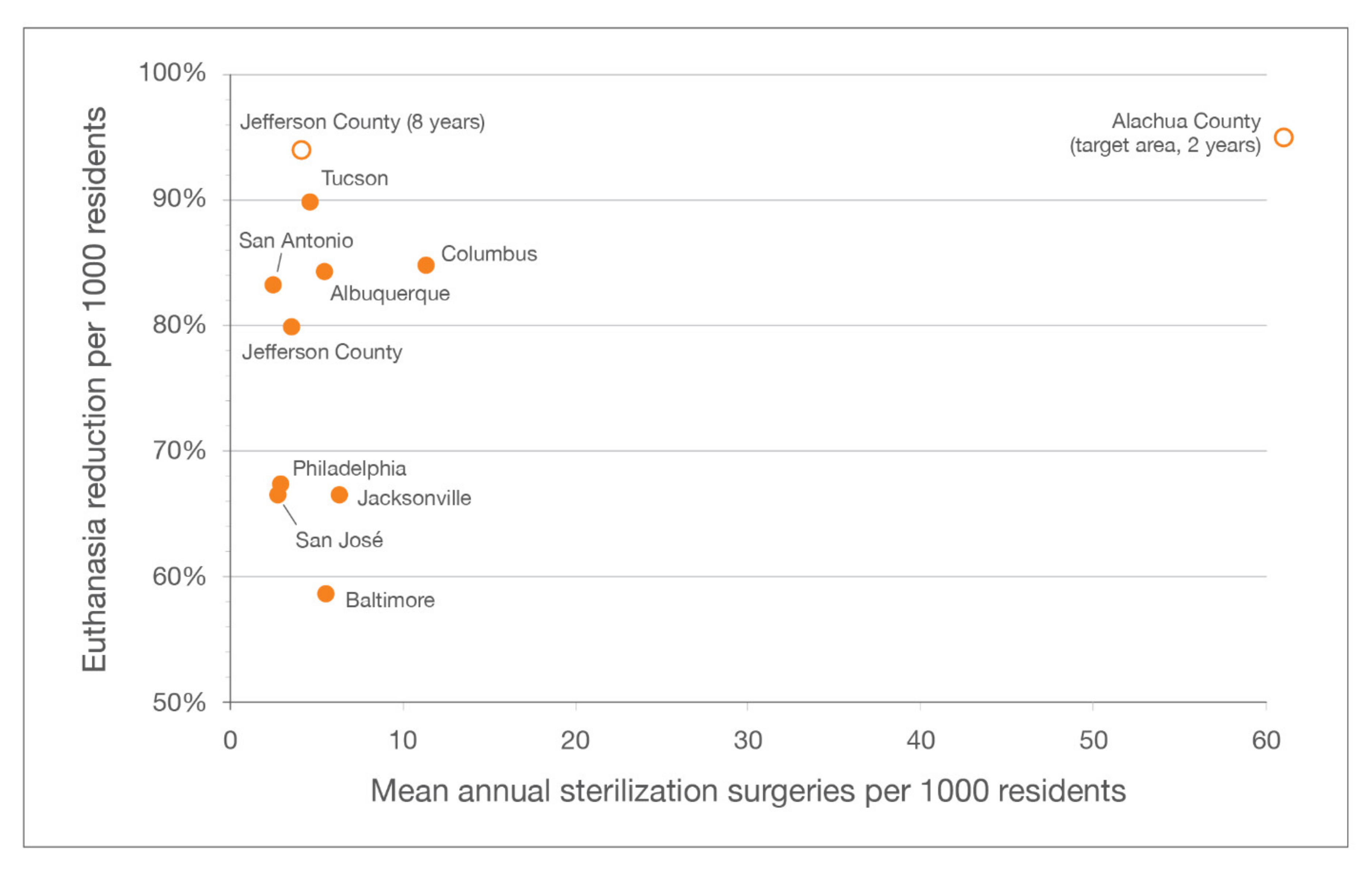

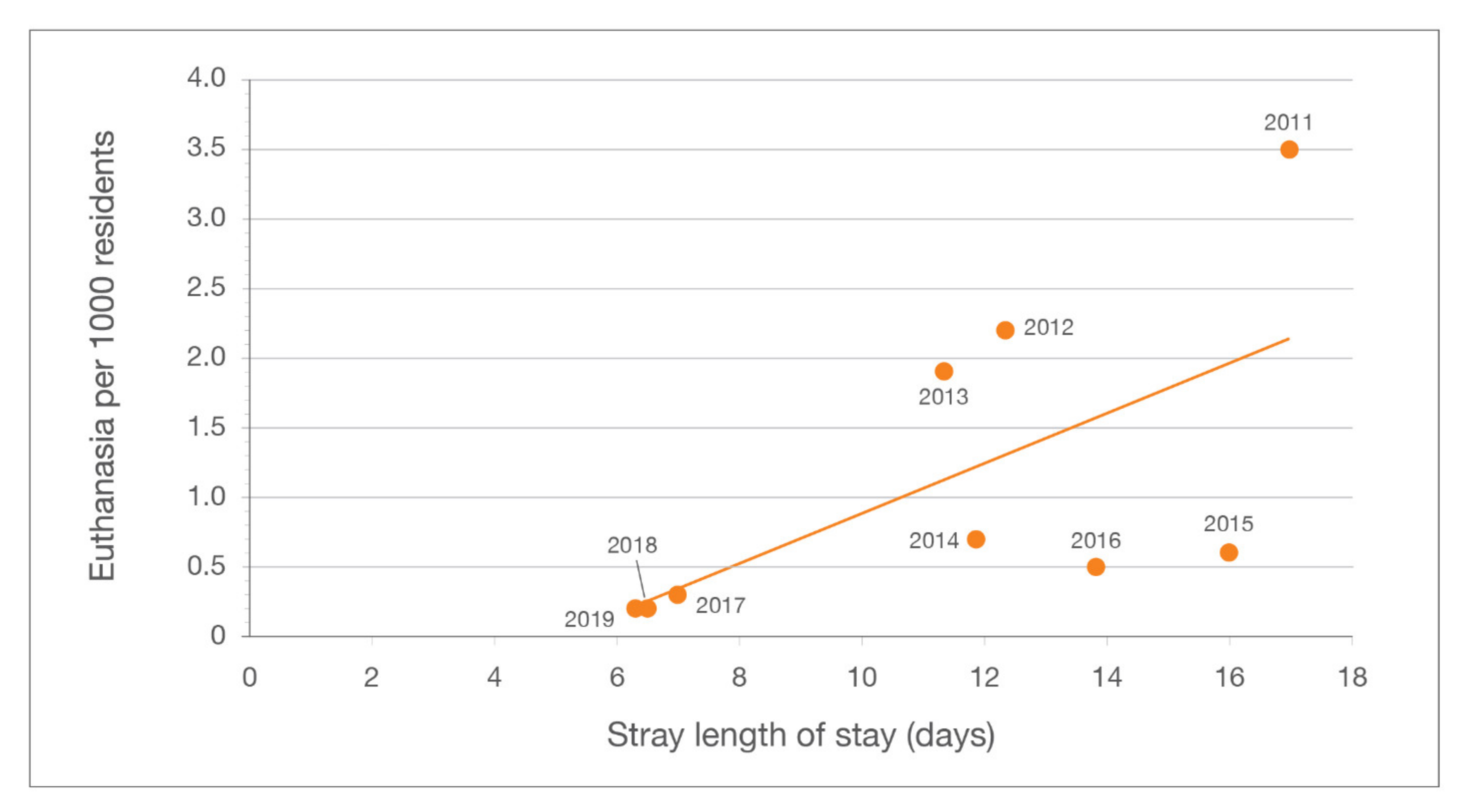
| 2011 (Baseline) | Y1 | Y2 | Y3 | Y4 | Y5 | Y6 | Y7 | Y8 | |
|---|---|---|---|---|---|---|---|---|---|
| Intake Category | |||||||||
| Stray intake | 3341 | 2724 | 3185 | 2365 | 2366 | 2246 | 1857 | 2473 | 2406 |
| Owner surrendered | 1379 | 968 | 789 | 833 | 647 | 617 | 313 | 248 | 252 |
| Confiscation | 7 | 11 | 21 | 28 | 38 | 34 | 24 | 55 | 48 |
| Total feline intake | 4727 | 3703 | 3995 | 3226 | 3051 | 2897 | 2194 | 2776 | 2706 |
| Outcome category | |||||||||
| Returned * | 0 | 373 | 891 | 627 | 811 | 793 | 262 | 996 | 1080 |
| RTF | 0 | 313 | 793 | 500 | 724 | 701 | 131 | 907 | 920 |
| Medical only | 0 | 60 | 98 | 127 | 87 | 92 | 131 | 89 | 160 |
| % of strays returned | 0.0 | 13.7 | 28.0 | 26.5 | 34.3 | 35.3 | 14.1 | 40.3 | 44.9 |
| Adoptions | 929 | 884 | 840 | 899 | 890 | 1043 | 1166 | 1036 | 1120 |
| To rescue † | 661 | 595 | 704 | 1008 | 624 | 562 | 572 | 427 | 191 |
| RTO | 75 | 95 | 72 | 62 | 55 | 51 | 61 | 73 | 87 |
| Euthanasia | 2626 | 1657 | 1455 | 531 | 466 | 384 | 209 | 149 | 155 |
| Died in care | 144 | 92 | 60 | 45 | 45 | 72 | 48 | 33 | 54 |
| Feline LRR (%) | 38.0 | 53.7 | 63.0 | 83.2 | 83.8 | 86.7 | 91.7 | 94.4 | 94.1 |
| Community/Program | Baseline | Y1 | Y2 | Y3 | Y4 | Y5 | Y6 | Y7 | Y8 | Mean Annual Sterilizations |
|---|---|---|---|---|---|---|---|---|---|---|
| Jefferson County, KY | 3.5 | 2.2 | 1.9 | 0.7 | 0.6 | 0.5 | 0.3 | 0.2 | 0.2 | 4.0 |
| Jacksonville, FL | 13.2 | 11.3 | 7.0 | 4.4 | 3.8 | 2.5 | 6.0 | |||
| San José, CA | 7.2 | 5.5 | 3.2 | 2.4 | 2.2 | 1.6 | 2.7 | |||
| Albuquerque, NM | 4.5 | 1.9 | 1.0 | 0.7 | 5.4 | |||||
| Baltimore, MD | 3.4 | 1.7 | 1.7 | 1.4 | 5.5 | |||||
| Columbus, GA | 7.3 | 2.9 | 1.2 | 1.1 | 11.3 | |||||
| Philadelphia, PA | 4.0 | 2.5 | 1.8 | 1.3 | 2.9 | |||||
| San Antonio, TX | 2.4 | 1.7 | 0.7 | 0.4 | 2.4 | |||||
| Tucson, AZ | 3.0 | 0.4 | 0.3 | 0.3 | 4.6 |
| Community/Program | Baseline | Y1 | Y2 | Y3 | Y4 | Y5 | Y6 | Y7 | Y8 | Mean Annual Sterilizations |
|---|---|---|---|---|---|---|---|---|---|---|
| Jefferson County, KY | 6.3 | 4.9 | 5.3 | 4.2 | 4.0 | 3.8 | 2.8 | 3.6 | 3.5 | 4.0 |
| Jacksonville, FL | 15.6 | 15.0 | 14.6 | 11.4 | 10.9 | 10.5 | 6.0 | |||
| San José, CA | 10.2 | 9.1 | 8.2 | 7.2 | 7.6 | 7.0 | 2.7 | |||
| Albuquerque, NM | 14.6 | 11.9 | 9.8 | 9.0 | 5.4 | |||||
| Baltimore, MD | 11.2 | 10.8 | 9.6 | 9.7 | 5.5 | |||||
| Columbus, GA | 16.3 | 12.1 | 9.7 | 9.4 | 11.3 | |||||
| Philadelphia, PA | 12.2 | 10.8 | 9.0 | 8.2 | 2.9 | |||||
| San Antonio, TX | 3.8 | 5.6 | 3.6 | 3.5 | 2.4 | |||||
| Tucson, AZ | 7.7 | 6.0 | 5.9 | 5.2 | 4.6 |
© 2020 by the authors. Licensee MDPI, Basel, Switzerland. This article is an open access article distributed under the terms and conditions of the Creative Commons Attribution (CC BY) license (http://creativecommons.org/licenses/by/4.0/).
Share and Cite
Spehar, D.D.; Wolf, P.J. The Impact of Return-to-Field and Targeted Trap-Neuter-Return on Feline Intake and Euthanasia at a Municipal Animal Shelter in Jefferson County, Kentucky. Animals 2020, 10, 1395. https://doi.org/10.3390/ani10081395
Spehar DD, Wolf PJ. The Impact of Return-to-Field and Targeted Trap-Neuter-Return on Feline Intake and Euthanasia at a Municipal Animal Shelter in Jefferson County, Kentucky. Animals. 2020; 10(8):1395. https://doi.org/10.3390/ani10081395
Chicago/Turabian StyleSpehar, Daniel D., and Peter J. Wolf. 2020. "The Impact of Return-to-Field and Targeted Trap-Neuter-Return on Feline Intake and Euthanasia at a Municipal Animal Shelter in Jefferson County, Kentucky" Animals 10, no. 8: 1395. https://doi.org/10.3390/ani10081395
APA StyleSpehar, D. D., & Wolf, P. J. (2020). The Impact of Return-to-Field and Targeted Trap-Neuter-Return on Feline Intake and Euthanasia at a Municipal Animal Shelter in Jefferson County, Kentucky. Animals, 10(8), 1395. https://doi.org/10.3390/ani10081395





